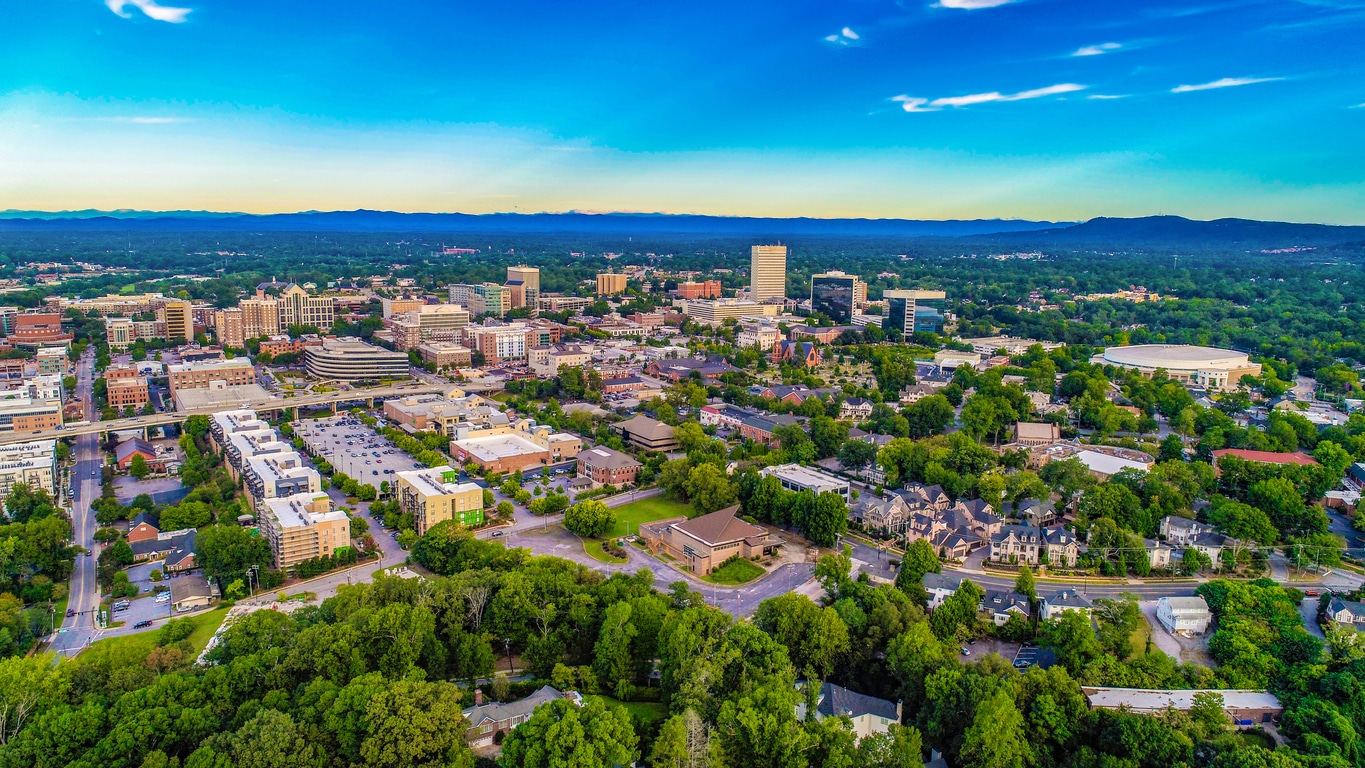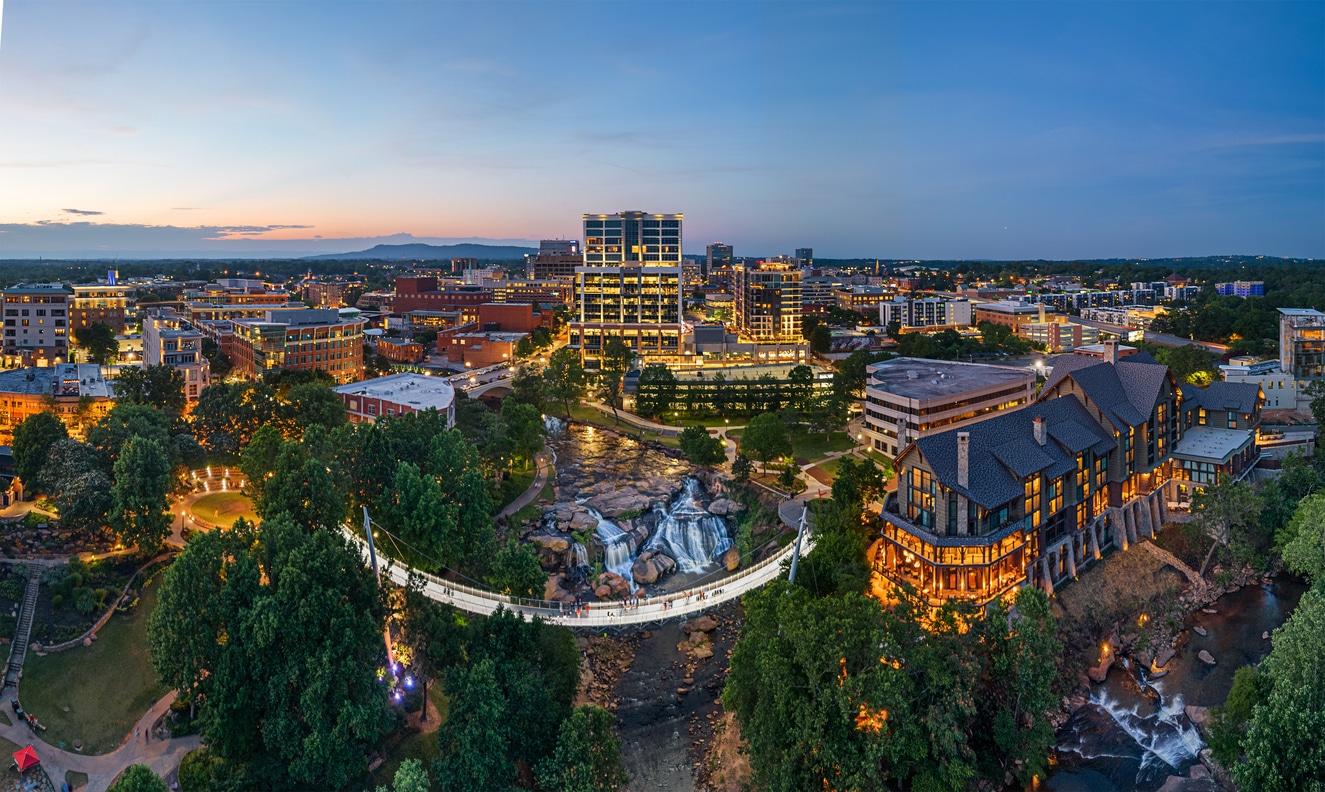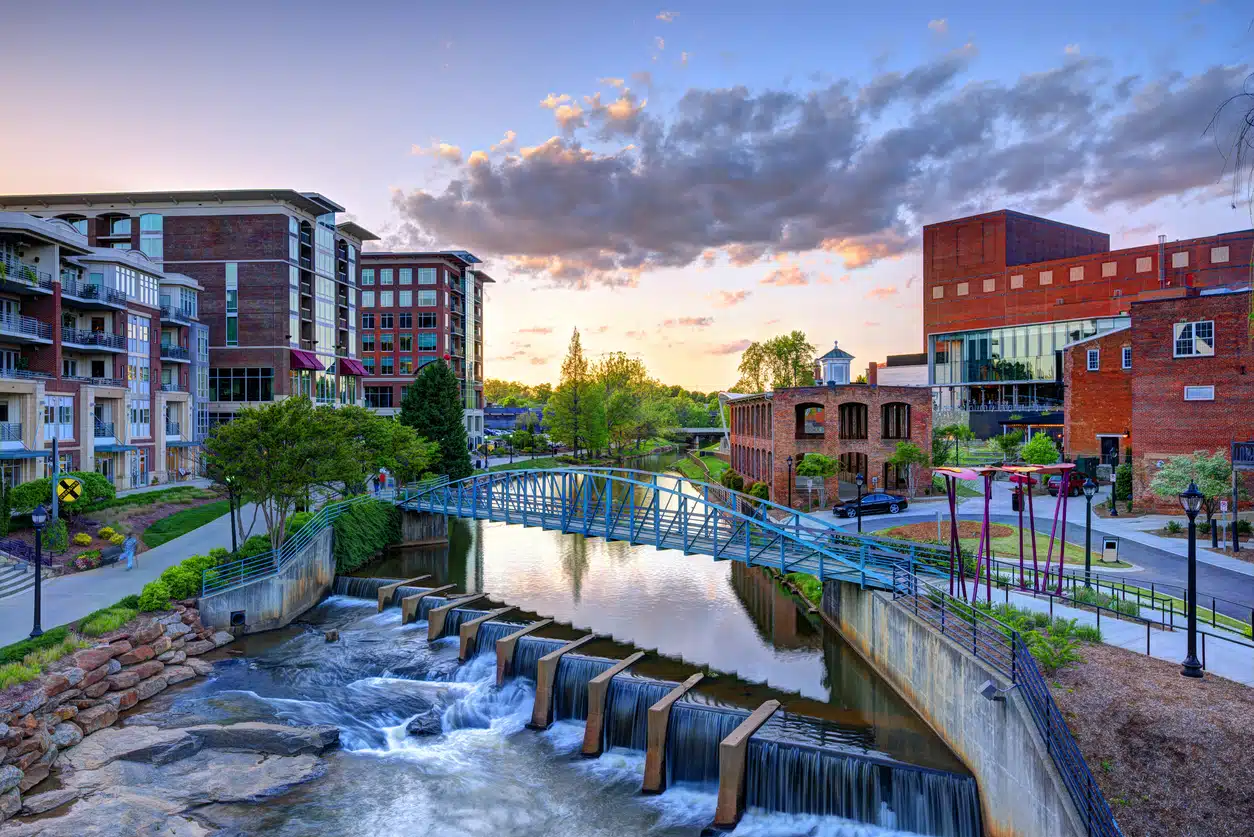Living in Greenville, SC: 8 Things to Know Before You Move
Moving to Greenville, SC, means a chance to enjoy a high quality of life in one of the South’s most charming cities. Nestled in the foothills of the Blue Ridge Mountains, Greenville offers the perfect blend of small-town friendliness and big-city amenities.
People love living in Greenville, SC, for its affordable cost of living, vibrant downtown, and abundant outdoor activities. It’s no surprise this city has been ranked among the best places to live in the U.S. in recent years. Whether you’re drawn by the strong job market or the scenic parks and trails, Greenville has something for everyone.
So — is Greenville, South Carolina, a good place to live? The answer is a resounding yes, especially if you value affordability, natural beauty, and community spirit. Residents enjoy a cost of living about 7–9% below the national average, meaning your dollar stretches further here than in many other cities. Greenville’s downtown is bustling with restaurants, shops, and cultural venues, yet it retains a welcoming, small-city feel. Add in the mild climate and proximity to both mountains and beaches, and it’s easy to see why so many folks are moving to Greenville, SC.
But of course, it’s not a fit for everyone. In this guide, we’ll deliver a curated list of things to know before you make your decision. From the cost of living in Greenville, SC, and housing market trends, to climate, crime, neighborhoods, and fun things to do, we’ve got you covered. Let’s dive in!
8 Things To Know About Living in Greenville, SC, Before Making the Move
Before you pack your bags and head for South Carolina’s Upstate, here are 8 key facts and insights about living in Greenville, SC. This list will help you hit the ground running and decide if Greenville is the right fit for your lifestyle.
1. The cost of living in Greenville, SC, is lower than in big cities
One of the biggest perks of moving to Greenville, SC, is the affordable cost of living. Overall, Greenville’s cost of living is about 7–9% lower than the U.S. average, which means you get more bang for your buck, particularly when it comes to housing. Greenville’s housing costs are roughly 25%–27% lower than the national average, a huge advantage for anyone relocating from an expensive market.
To put that in perspective, living in Greenville is dramatically cheaper than living in many major metros. For example, the cost of living in Greenville, SC, is about 45% lower than in New York City. That means someone earning $100,000 in Manhattan would only need to earn roughly $55,000 to maintain the same standard of living in Greenville.
What is a livable salary in Greenville, SC? For a single adult, a “living wage” in the Greenville area is estimated at about $21.54 per hour, or $44,800 a year. That would cover basic necessities for one person. Of course, determining your actual livable salary depends on your lifestyle, but many residents feel comfortable with incomes that are modest by big-city standards.
Importantly, South Carolina’s taxes are relatively friendly on the wallet: the state boasts low property taxes (around 0.5% effective rate) and moderate income taxes (with the top bracket recently reduced to 6.5%). There’s also no local city income tax. So while you’ll still pay sales tax (6% state rate in Greenville) and state income tax, the overall tax burden in Greenville isn’t bad at all.

2. Expect hot summers, mild winters, and plenty of sunshine from Greenville’s climate
When it comes to weather, Greenville has a humid subtropical climate. That means you can expect hot, humid summers and short, mild winters. In July (the hottest month), average highs are in the upper 80s°F, often reaching the 90s with plenty of southern humidity. You’ll definitely get a long summer suitable for swimming, boating, and enjoying cold sweet tea in the shade. Spring and fall in Greenville are absolutely gorgeous — warm days and cool nights, with blooming azaleas in spring and vibrant foliage come October.
Winters are quite moderate. Snow isn’t a big concern, as Greenville averages only about 4–5 inches of snow per year, mainly in January or February, if the flakes fly at all. Daytime winter temperatures typically hover in the 50s°F, with nights in the 30s. It’s rare for the temperature to stay below freezing all day (on average, only about 1 day a year fails to rise above freezing).
In terms of extreme weather, hurricanes are not a big threat in Greenville. Even though hurricane season runs from June through November in South Carolina, Greenville’s inland location means it’s in a low-risk hurricane zone. Historically, very few hurricanes have reached the Greenville area with any strength (the last significant ones were remnants of Ivan in 2004 and Cindy in 2005). However, the region is part of “Dixie Alley,” so tornadoes are a possibility.
Ready to make the move to Greenville? Get a fast, free quote from Colonial. |
3. Crime in Greenville, SC, is higher than average (but many safe areas exist)
Like most cities, Greenville has its safer neighborhoods and its rougher spots. Overall, the Greenville crime rate is above the national average. Recent data shows the city’s total crime rate is about 81% higher than the U.S. average.
Those figures can sound alarming, but they don’t mean Greenville is unsafe. In fact, many residents will tell you they feel safe in their day-to-day lives.
As with any city, certain neighborhoods have significantly higher crime rates and skew the average. According to local insight, some of the high-crime areas of Greenville include parts of downtown (especially late at night), the area around Haywood Mall, and neighborhoods like Arcadia Hills, Southernside, and West Greenville. These are places where you’d want to be more vigilant. On the flip side, Greenville has plenty of safe neighborhoods. In fact, Greenville was recently listed among the top 20 safest cities in South Carolina.
Areas like North Main, Augusta Road, and Gower Estates are known to be very safe, community-oriented neighborhoods with low crime rates. Other safe Greenville neighborhoods mentioned by locals include Dellwood (near Bob Jones University), Botany Woods, and Heritage Creek on the southeast side. Many of these have strong community watch programs and a low incidence of violent crime, making them popular for families and retirees.

4. The Greenville, SC, housing market is hot but not overpriced
If you’re eyeing homeownership after moving to Greenville, you’ll be happy to find a competitive yet relatively affordable housing market. The median home value in Greenville is around $326,000 (as of mid-2025), which is significantly lower than the U.S. median home price (well over $400,000).
In fact, Greenville’s home value median is also far below cities like Charleston, SC, (around $500K) and many metros nationwide. Over the past year, Greenville’s home values increased only about 0.5%, indicating the market has cooled and stabilized compared to the rapid growth seen in 2020–2022. This means we’re not seeing a wild bubble; instead, prices are holding steady with modest growth.
The Greenville, SC, housing market in 2025 could be described as active but not crazy. Homes do sell quickly, with the average listing going under contract in about 15 days, so buyers should be prepared to move fast on a desirable property. Inventory is a bit limited (under 900 homes on the market in mid-2025), which can create competition, especially for homes under the ~$300K range, which are snapped up by first-time buyers.
Get started on your move: Your first step is to download our moving checklist. |
5. If you’re renting in Greenville, you’ll find affordable options from downtown to suburbs
Not ready to buy a house? Greenville’s rental market also has plenty of options, from trendy downtown apartments to suburban homes for rent. The average rent in Greenville is around $1,582 per month for an apartment, which is about 10% lower than the national average rent.
New luxury apartments in downtown or popular areas (with pools, gyms, etc.) will be on the higher end. It’s not uncommon to see a 2-bedroom in a brand-new downtown complex go for $1,800+. On the other hand, if you look at older complexes or rentals farther from the city center, you can find 1-bedroom units under $1,000 and great deals for what you get.
Need packing advice? Check out our pro tips on how to pack for a move. |
6. The Greenville job market is diverse and growing
Greenville’s economy is often called the “economic engine of South Carolina,” and for good reason. Unemployment in Greenville is low (hovering around 3–4% in 2024-2025, which is on par with or better than the national rate).
The Greenville area boasts a diverse and robust job market, with opportunities in a variety of industries. If you’re moving to Greenville, SC, for work, you’ll find major industries include manufacturing, automotive, technology, healthcare, education, and tourism.
Manufacturing and automotive are huge here. The Upstate is home to companies like BMW, which operates a massive manufacturing plant in nearby Spartanburg, Michelin North America, which is headquartered in Greenville County, GE (General Electric), and 3M, among others. These companies provide thousands of jobs in engineering, production, and management.
In fact, Greenville has more corporate headquarters than any other region in the state. Companies like Fluor (engineering), Lockheed Martin (aerospace), and Hubbell Lighting have significant operations here. The presence of these companies means plenty of high-paying jobs for professionals in engineering, tech, and business.
The healthcare sector is another major employer. The largest employer in Greenville is Prisma Health (the regional hospital system), followed by the Greenville County School District and Bon Secours St. Francis Health System. There’s also a growing tech and innovation scene, with the NEXT Innovation Center and other startup hubs located downtown.

7. Best places to live in Greenville, SC
Greenville and its surrounding communities have many great neighborhoods, so many that it can feel overwhelming to choose. To help narrow it down, here are three of the best places to live in the Greenville, SC, area, each with its own character.
Of course, these are just a few of the best places to live in Greenville. Other notable areas include North Main (historic and hip), Travelers Rest (a small town just north of Greenville, great for outdoorsy folks), and Greer (another growing city between Greenville and Spartanburg). Depending on your priority — be it schools, commute, or nightlife — you’ll find a Greenville neighborhood or suburb that feels like home.
Augusta Road area (Alta Vista): Best for families
The Augusta Road area (sometimes called Alta Vista, along with surrounding neighborhoods) is one of Greenville’s most desirable spots for families. Located just south of downtown, Augusta Road is an established, tree-lined community known for its beautiful historic homes, top-notch schools, and strong sense of community.
Families are drawn here because the schools are excellent. Augusta Circle Elementary, for example, is one of the highest-rated elementary schools in the state.
The neighborhood streets are peaceful and walkable, dotted with playgrounds and local shops.
Downtown Greenville & West End: Best for young adults and nightlife
For young adults, singles, or anyone who wants to be in the heart of the action, Downtown Greenville is the place to live, and especially the West End.
Downtown Greenville has garnered national attention for its revitalization; it’s vibrant, walkable, and packed with restaurants, bars, cafes, galleries, and shops. Living downtown means you can stroll to the Saturday farmers market on Main Street, catch a baseball game at Fluor Field in the West End, and enjoy nightlife without worrying about driving home.
Simpsonville: Safest and most affordable
If you’re looking for affordability, safety, and a suburban atmosphere, check out Simpsonville, SC. Located about 20 minutes southeast of Downtown, Simpsonville is actually a separate small city in the Greenville metro, but it’s one of the most popular places for those who work in Greenville.
Why? It offers some of the best bang for your buck in terms of housing, along with low crime and great schools. Simpsonville consistently ranks as one of the safest cities in South Carolina (crime rates here are well below state and national averages). It’s the kind of place with quiet subdivisions, new shopping centers, and plenty of parks.

8. There are plenty of things to do in Greenville, SC
You’ll never be bored living in Greenville, SC. The area is packed with activities for all ages and interests. Here are some of the top things to do and must-see attractions once you’re a Greenvillian:
Cultural experiences: Catch a show, concert, or ballet at the Peace Center for the Arts, a world-class performing arts venue on the Reedy River.
Family fun: Take the kids to The Children’s Museum of the Upstate — 80,000 square feet of interactive exhibits that will spark any child’s imagination — or spend a day at the Greenville Zoo in Cleveland Park.
Outdoor activities: Enjoy Greenville’s natural beauty at Falls Park and the Swamp Rabbit Trail on the Reedy, a stunning downtown oasis with gardens and waterfalls.
Seasonal events and festivals: Mark your calendar for Fall for Greenville, the city’s signature free admission food and music festival held each October.
Nightlife and dining: On a night out, explore the thriving downtown dining scene. Greenville has over 200 restaurants downtown, from upscale Southern cuisine at Soby’s to trendy spots like Jianna (Italian) or Vault & Vator (a speakeasy-style bar).
Pros and Cons of Living in Greenville, SC
Every city has its highs and lows. After covering all these aspects of life in Greenville, here’s a quick summary of the pros and cons of living in Greenville, SC:
Pros of Living in Greenville, SC:
Affordable cost of living: Overall expenses (especially housing) are lower than the national average, so your money goes further.
Strong job market: Diverse economy with plenty of jobs in manufacturing, healthcare, tech, and more, along with a low unemployment rate.
Vibrant downtown and food scene: Greenville’s downtown is lively and beautiful, with excellent restaurants, shops, and cultural venues (a foodie haven and very walkable).
Outdoor recreation: Easy access to parks, trails (Swamp Rabbit!), mountains, and lakes for hiking, biking, and adventures, all great for an active lifestyle.
Mild climate: Short, mild winters and long warm seasons mean you can enjoy outdoor activities year-round (no brutal winters).Community and size: Greenville offers a friendly, small-city feel with the amenities of a larger city. It’s clean, family-friendly, and people tend to be welcoming.
Cons of Living in Greenville, SC:
Hot summers: Summers are hot and humid; the heat and mugginess can be intense in July and August if you’re not used to Southern weather.
Limited public transportation: The area is car-dependent. Public transit options are limited, so you’ll likely need to drive everywhere.
Higher crime pockets: While many areas are safe, the city does have higher-than-average crime rates in certain neighborhoods, requiring some awareness and research on where to live.
Growing traffic: Rapid growth has led to more traffic congestion on key roads. Driving is generally easy, but some hotspots (e.g., Woodruff Road and downtown at rush hour) can be frustrating.
Distance from big cities and the ocean: Greenville is a few hours’ drive from the nearest major cities (Atlanta and Charlotte) and about 3.5 hours from the beach.
Overall, the pros of living in Greenville, SC, outweigh the cons for most residents. The area’s affordability, charm, and opportunities make it a highly attractive place to call home. The few downsides — like hot summer weather or the need for a car — are relatively minor trade-offs for the benefits you get.
Ready to Move to Greenville? Here’s Your Next Step
Greenville offers an appealing mix of low-cost living, Southern hospitality, and dynamic growth. If you love the idea of affordable homes, a strong job market, year-round outdoor fun, and a friendly community — and if a bit of summer heat or a car-centric layout doesn’t bother you — then moving to South Carolina, and specifically Greenville, should definitely be on the top of your to-do list.
When you’re ready to take the leap, let Colonial Van Lines take care of your move. With over 50 years of experience in long-distance moving and a stellar reputation, our team of highly trained movers will handle all the heavy lifting (and driving) so you can focus on settling into your Greenville life. As experienced full-service movers, we offer a hands-of experience that’s as easy and smooth as possible, from professional packing and loading to safe transportation and loading at your new home. Get your free quote today!

